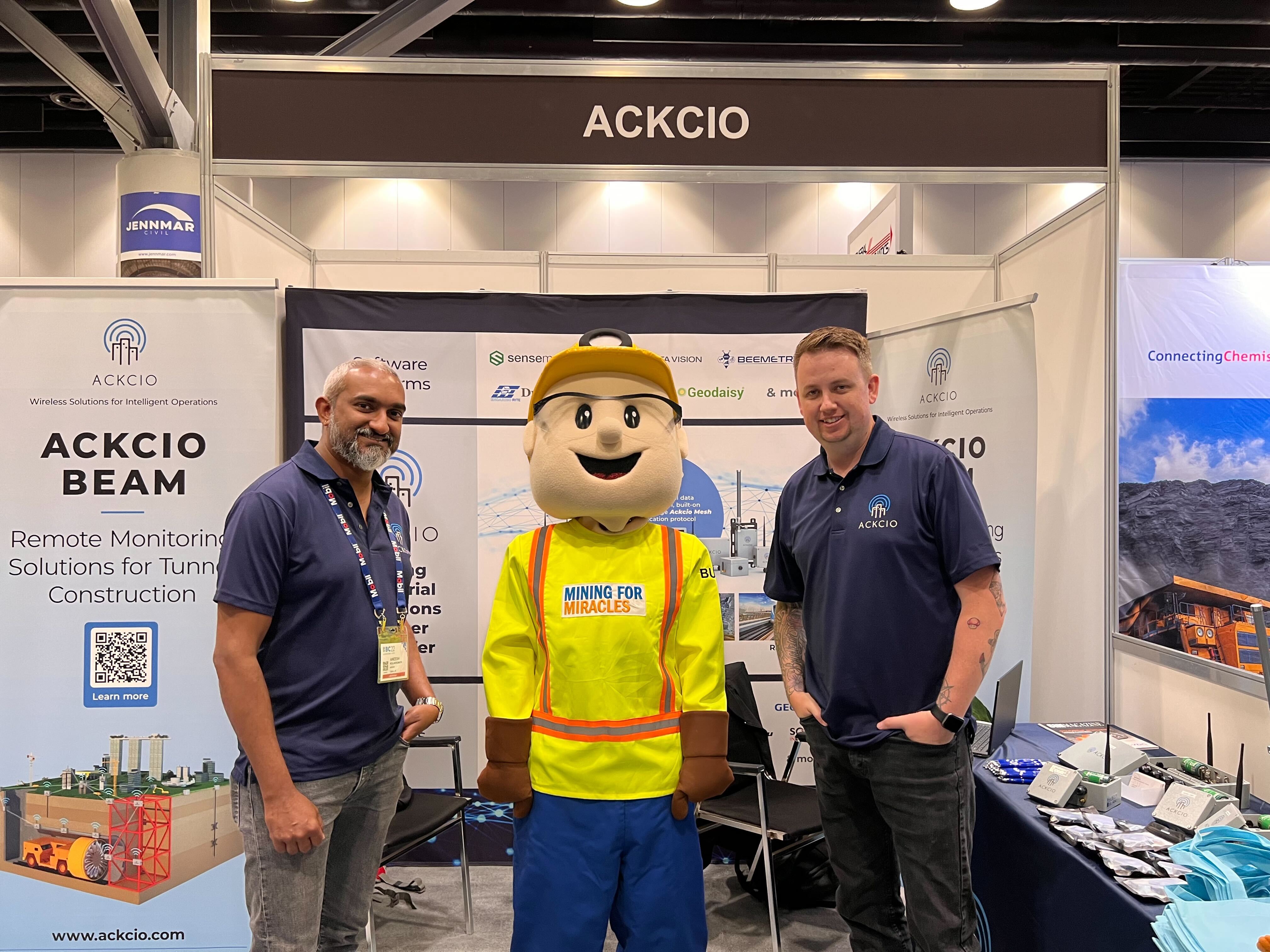
Wireless Monitoring Drives Efficiency, Safety & Savings on Construction & Infrastructure Projects
Infrastructure and construction sites are busy, complex and often sprawling locations, with multiple teams at work at numerous tasks at any one time.
Tunnels, dams, bridges, large-scale construction projects: traditionally, they’ve been monitored by sensors connected to a complex spiderweb of cables crisscrossing the site.
“And the more cabling you have, the bigger and more complicated that web becomes,” says Shaun Ahern, Global Sales Director at Ackcio, a global provider of long-range wireless data acquisition systems for industrial applications. “It’s a vicious cycle. With the legacy systems, if you want to improve safety, your costs increase with higher installation and maintenance while inadvertently creating a more hazardous web of cables.”
Expensive to buy and install, cumbersome to maintain, and a hazard to people, equipment and assets, these old hard-wired systems are rapidly becoming replaced by emerging digital technologies.
Today, many contractors and project owners are opting for smarter, safer monitoring solutions that cut costs, reduce risk, improve data transmission and drive new levels of efficiency and productivity while, most importantly, improving safety. Wireless technology is revolutionizing the monitoring of large-scale, high-consequence infrastructure and construction projects, providing previously unimaginable volumes of reliable, real-time data over long ranges.
And all without a lengthy cable.
Low Entry Costs
The initial investment in physical cabling to wire the sensors on an infrastructure project or construction site is staggering. Typically cable costs approximately $1/metre. There can be 40-50 km of wires connecting all the sensors to a cable-based logger in large projects. The larger the area, the more cabling is needed and the more complicated and costly it gets.
Along with the cost of installing cable and building the infrastructure, such as underground trenches, to support it, there are the related human resources costs, for workers to gather readings in manual set-ups or for maintenance in the case of all-too-frequent cable damage or failure.
Compare that to the initial investment in wireless systems, which is much lower, with a much quicker ROI. Easy to deploy and install, wireless equipment–nodes and gateways–can be used in multiple projects so the investment can be spread out.
When Neste was expanding its renewables refinery in Singapore, a four-year, US$1.75 billion project, they were looking for a wireless option to monitor the 1,800m2 site. They chose Ackcio Beam, comprising 10 Ackcio Vibrating Wire Nodes (BEAM-VW-S8) monitoring 80 strain gauges once every hour, sending readings to the Ackcio Gateway via its dynamic mesh network.
In switching from cabled to wireless monitoring, they saved up to 40%–or almost US$370,000 –in labour costs. There were other benefits, as well, including easy scalability as the work progressed. And real-time monitoring capabilities significantly improved the site’s productivity and overall efficiency.
“By using Ackcio Beam, we managed to save a significant amount of time, man-hours, and labour costs, and comfortably fulfilled all of our monitoring requirements,” says Elson Kong from Kimaro, the project’s geotechnical engineering solutions provider. “It certainly made our work easier when monitoring the vast network of strain gauges we had deployed across the site.”
Tightening Regulations, Higher Standards
Even in locations where labour is inexpensive, increasing regulatory and corporate social responsibility pressures make the move to efficient wireless practically a no-brainer. Yesterday’s standards are not good enough for buildings and infrastructure that are meant to last decades.
Meanwhile, tender specifications increasingly require wireless and real-time remote monitoring, which is becoming the international standard. Wireless is simply the way the industry is going. It’s easy to understand why.
On large-scale, high-consequence projects like these, where the scope is great, so are the stakes. Risk mitigation is essential to preventing accidents and failures that can cost millions or billions of dollars, endanger human lives and the environment, and cause irreparable damage to a project owner’s reputation.
And when it comes to operations, nothing affects the efficiency and productivity of these sorts of massive projects more than a shutdown. Real-time data empowers contractors and project owners to develop rich data pictures over time and immediately investigate if there’s an anomaly or threshold reached, reducing the chance of a stop-work order.
“The whole idea of having a real-time solution is to be able to predict what might happen and see what is happening to prevent it,” says Shaun Ahern of Ackcio. “So you're improving safety, you're maintaining or improving operational efficiency, and ultimately productivity. That's a significant benefit of wireless systems.”
The Buzz About the Beam
Eliminating cables removes many of the risk factors associated with legacy approaches. But some veterans in the infrastructure and construction industries have resisted wireless monitoring systems because of outdated concerns around battery-powered systems. They needn’t worry: recent electronics advances are opening new horizons for IoT devices, which consume micro and nano amperes of energy, lasting for years on batteries.
Another lingering and legitimate concern with wireless solutions is occasional data loss, but this is more applicable to star topologies (LoRa-based solutions) where each node must “speak” directly to the gateway. If there’s a communication failure because of blockage or interference, at best, the data can be manually read. In most cases, however, the data will be lost. With a mesh system, though, the node has multiple routes back to the gateway.
_Page_1.png?width=1200&name=Ackcio%20Beam%20Wireless%20Monitoring%20Solutions%20(Dec%202021)_Page_1.png)
“In a high-noise environment in a really complex site, we can communicate through different points, including from datalogger and repeater nodes,” Shaun says. “This means that we can go into far more dynamic projects that are constantly changing and growing and monitor them without fear of interruption.”
And in those rare instances of a transmission blockage, Ackcio’s unique fail-safe data collection feature ensures that no readings are lost. When the connection resumes, the data backed up on the nodes is seamlessly sent to the gateway.
Going Further
While wireless mesh technology has been around for a while, its transmission capabilities have been mostly constrained to short-range. Ackcio has pushed past the range limits of other wireless mesh systems, developing a proprietary, patented communications technology that can send a signal up to 10 km. And its equipment can be used in some of the toughest conditions, both above ground and underground, between temperatures of -40 to +80 degrees C. It’s also sensor-agnostic, pairing with all major sensor and monitoring software.
As demonstrated in the Neste refinery expansion project, long-range, wireless mesh solutions, such as the Ackcio Beam, are actively advancing monitoring for large-scale infrastructure and construction projects to benefit project owners, workers, and the environment.
“Given the vastness of the deployment area, the challenging site conditions, and our requirement to reliably acquire data at short intervals, this solution really ticked all the boxes,” says Terence Teo of CEP, a geotechnical instrumentation service provider on the project. “We’re glad we recommended Ackcio for this project.”






